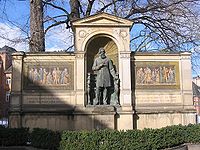
Heino Schmieden
Encyclopedia


Germany
Germany , officially the Federal Republic of Germany , is a federal parliamentary republic in Europe. The country consists of 16 states while the capital and largest city is Berlin. Germany covers an area of 357,021 km2 and has a largely temperate seasonal climate...
architect
Architect
An architect is a person trained in the planning, design and oversight of the construction of buildings. To practice architecture means to offer or render services in connection with the design and construction of a building, or group of buildings and the space within the site surrounding the...
.
Biography
Schmieden was born in Soldin, New March (modern Myślibórz, Poland)In 1866 Schmieden graduated from the renowned Bauakademie
Bauakademie
The Bauakademie in Berlin, Germany, built between 1832 and 1836, is considered one of the forerunners of modern architecture due to its theretofore uncommon use of red brick and the relatively streamlined facade of the building.Designed by Karl Friedrich Schinkel, the Bauakademie was built near...
in Berlin with a diploma in architecture
Architecture
Architecture is both the process and product of planning, designing and construction. Architectural works, in the material form of buildings, are often perceived as cultural and political symbols and as works of art...
. Even during his last year at the school he had been continuing his studies with trips to France, England and Italy.
With high artistic aspirations he produced plans for museums, hospitals, monuments and villas in addition to conceiving numerous residence and office buildings. Until Martin Gropius
Martin Gropius
Martin Carl Philipp Gropius was a German architect.- Life :Gropius studied at the Bauakademie in Berlin and after graduation worked as a private architect...
' death in 1880, he and Schmieden worked together to develop their architecture firm, Fa. Gropius & Schmieden, into one of Berlin's greatest. The firm continued to produce great work thereafter as Schmieden teamed up with such notable architects as Robert Speer
Robert Speer
Robert Speer may refer to:*Robert Milton Speer , American politician from Pennsylvania*Robert W. Speer , Mayor of Denver, Colorado, United States*Robert Elliott Speer , American religious leader...
, Victor von Weltzien and Julius Boethke to run it.
The present-day Martin Gropius Bau
Martin Gropius Bau
Martin-Gropius-Bau, originally a museum of applied arts and a listed historical monument since 1966, is a well-known Berlin exhibition hall located at Niederkirchnerstraße 7 in Berlin-Kreuzberg.- History and architecture :...
in Berlin was built in 1881 based on plans by Schmieden and Martin Gropius
Martin Gropius
Martin Carl Philipp Gropius was a German architect.- Life :Gropius studied at the Bauakademie in Berlin and after graduation worked as a private architect...
as an applied art museum. It was constructed in the style of the Italian Renaissance
Renaissance
The Renaissance was a cultural movement that spanned roughly the 14th to the 17th century, beginning in Italy in the Late Middle Ages and later spreading to the rest of Europe. The term is also used more loosely to refer to the historical era, but since the changes of the Renaissance were not...
and has a central atrium. Mosaic
Mosaic
Mosaic is the art of creating images with an assemblage of small pieces of colored glass, stone, or other materials. It may be a technique of decorative art, an aspect of interior decoration, or of cultural and spiritual significance as in a cathedral...
s with allegories from various ages and the coats of arms
Coat of arms
A coat of arms is a unique heraldic design on a shield or escutcheon or on a surcoat or tabard used to cover and protect armour and to identify the wearer. Thus the term is often stated as "coat-armour", because it was anciently displayed on the front of a coat of cloth...
of german states decorate the spaces between windows.
In 1881 he became a member of the Berlin Bauakademie followed by his admittance in 1887 to the Akademie der Künste
Akademie der Künste
The Akademie der Künste, Berlin is an arts institution in Berlin, Germany. It was founded in 1696 by Elector Frederick III of Brandenburg as the Prussian Academy of Arts, an academic institution where members could meet and discuss and share ideas...
.
He is buried in the Alter St. Matthäus Kirchhof in the Schöneberg
Schöneberg
Schöneberg is a locality of Berlin, Germany. Until Berlin's 2001 administrative reform it was a separate borough including the locality of Friedenau. Together with the former borough of Tempelhof it is now part of the new borough of Tempelhof-Schöneberg....
neighborhood of Berlin.

